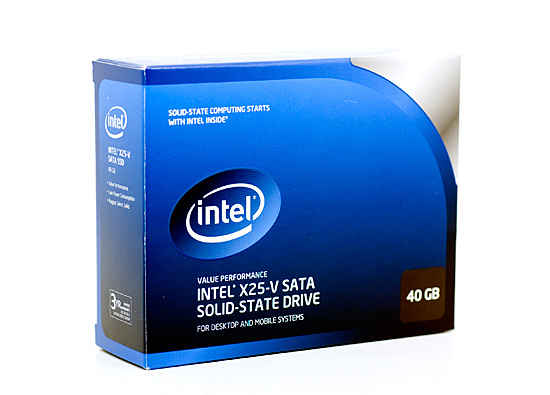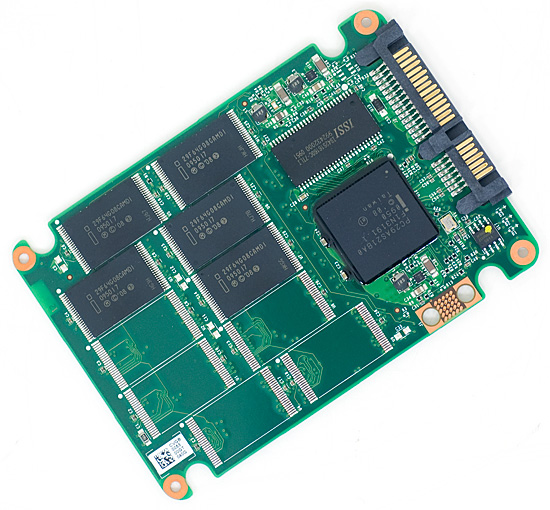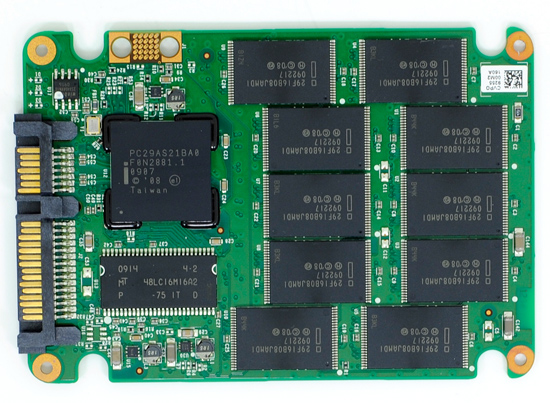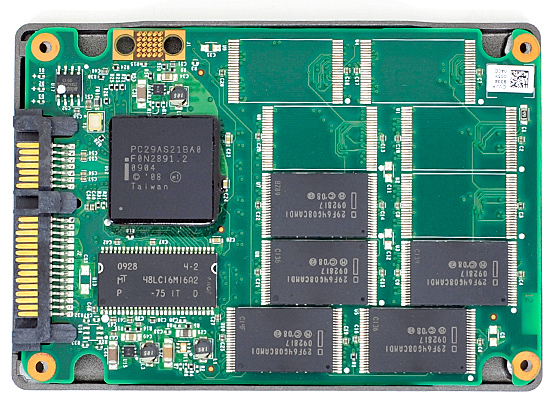Intel's X25-V & Kingston's 30GB SSDNow V Series: Battle of the $125 SSDs
by Anand Lal Shimpi on March 19, 2010 12:00 AM EST- Posted in
- Storage
V for Vende...Value
This is the first time I’ve actually received a retail boxed Intel SSD. The packaging actually mimics that of Intel’s boxed CPUs:

Inside the retail package you’ll find a full upgrade kit. You get a 3.5” mounting plate, a mini CD with an installation guide on it, one of those My SSD Rocks! stickers and the drive itself.

The X25-V ships in the same aluminum housing as the X25-M G2. Cracking it open reveals a bare side of the PCB:

Flipping it over we see the 5 x 8GB 34nm IMFT flash modules, the G2 controller and 32MB of PC133 SDRAM. The controller and SDRAM size/speed are identical to the 80 and 160GB G2s we reviewed last year.

Intel's X25-V PCB
With only half the channels populated, sequential write speed is about half of the X25-M G2 (~40MB/s vs. ~80MB/s). Remember that Intel’s controller uses free space as spare area, so with potentially less free space on the drive the 40GB X25-V will undoubtedly perform much worse than the 80GB or 160GB X25-Ms.

Intel's X25-M G2 PCB
In practice, the X25-V should perform very much like last year’s 40GB Kingston V Series Boot Drive. The two are identical minus official support for TRIM in the X25-V’s firmware.

Kingston's 40GB V Series Boot Drive PCB
Intel’s storage drivers (Intel RST 9.6) with TRIM support are expected to be available any day now so you’ll no longer have to rely on Microsoft’s AHCI drivers for TRIM.










78 Comments
View All Comments
Taft12 - Saturday, March 20, 2010 - link
The pricing changes every couple of minutes, what do you want?UPDATE 13: Zipzoomfly now has the Kingston drive for $84.77 beating Newegg's $84.99
hybrid2d4x4 - Friday, March 19, 2010 - link
Anand, in future SSD reviews, can you bring back the power consumption figures? Or maybe dedicate a short article that sums up the current lineup? I remember an article on Tom's which showed a huge amount of variance among 1st gen SSDs (with some being worse than "green" 3.5" HDDs) and am wondering how the current ones are versus a 2.5" laptop drive (ie: what impact a SSD swap will have on battery life).7Enigma - Saturday, March 20, 2010 - link
Agreed. I would be interested to see these figures as well. Doesn't really matter for a desktop setting but for a laptop replacement/upgrade it can be helpful.qwertymac93 - Friday, March 19, 2010 - link
so what your saying is...sandforce wins! Im kidding of course, but i think 30 gigs is too small, and the intel 40gig is too slow. too bad a 50 gig sandforce costs $250! o_Ompx - Friday, March 19, 2010 - link
If I had a small SSD, then I'd definitely use it as a cache, rather than as a boot drive. There are 2 popular solutions: ReadyBoost integrated in Windows 7, which supports up to 32GB of storage, matching these drives. There's also external program called ReadyBoost that can work with Window XP or Windows Server version.Nomgle - Wednesday, March 24, 2010 - link
ReadyBoost only caches Reads, and would be utterly useless in this scenario.As noted in the article, the "correct" way to use a small SSD is to install your OS directly onto it - use an additional mechanical drive as your main data store.
rivethead - Friday, March 19, 2010 - link
I guess I consider myself lucky that I purchased a Kingston SSDNow 40GB drive from Buy.com for $89. This was just eight weeks ago.A few hours of research and tweaking and a few aspirin later I was able to upgrade the firmware to the Intel firmware and enable TRIM.
So a big middle finger to you Intel.
Drakino - Friday, March 19, 2010 - link
Does the Intel drive adhere to connector location for 3.5 inch drives when mounted in the bracket? IE, can I toss the 2.5 inch drive onto the bracket, then mount the bracket in the drive carriers of a Mac Pro and plug it in?Western Digital failed this test with their initial release of the Velociraptor, only later coming out with a "Hot swappable" 3.5 inch form factor drive that adhered to SATA standards.
somedude1234 - Sunday, March 21, 2010 - link
I've been looking for a similar solution. Two similar items:Addonics Snap-In 25
Icy Dock MB882SP-1S-1B
Unfortunately, it looks like both of them use a separate PCB, which could possibly lead to connection problems.
I was looking for a dead-simple bracket that would offset the 2.5" drive to the proper location within a 3.5" drive space. The only candidate I've found so far is this:
Supermicro MCP-220-00043-0N
The pictures all show the complete Supermicro 3.5" hotswap carrier, including the metal bracket which properly places the 2.5" drive in the 3.5" drive space. It looks like the bracket is screw-mounted within the 3.5" carrier. I suspect that the MCP-220-00043-0N model number is actually for only the metal bracket and that the 3.5" hotswap carrier is simply shown for illustration. However, it's possible that they include both the bracket and the carrier. In that case, you could just remove the bracket and toss the carrier.
Nomgle - Wednesday, March 24, 2010 - link
The Icy Dock MB882SP-1S-2B and MB882SP-1S-1B work just fine to convert a 2.5" drive to a 3.5" form-factor, whilst keeping the SATA connectors in the right place -http://www.icydock.com/product/mb882sp-1s-2b.html">http://www.icydock.com/product/mb882sp-1s-2b.html and http://www.icydock.com/product/mb882sp-1s-1.html">http://www.icydock.com/product/mb882sp-1s-1.html